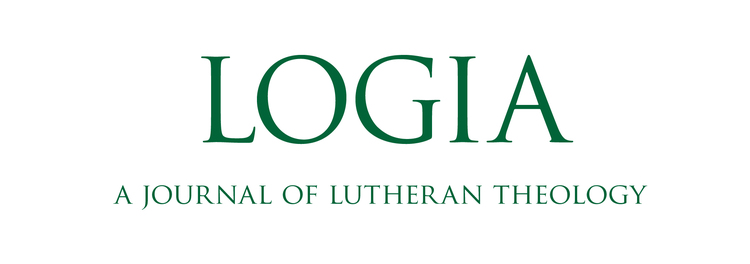Upcoming Themes
LOGIA is published quarterly (Epiphany, Eastertide, Holy Trinity, and Reformation).
34:3 (Holy Trinity 2025) — Marriage and Celibacy - - this is our current issue - purchase here.
God holds the estate of marriage so highly that, not only did he institute it in the garden and had Moses instantiate it in Genesis (1 and 2), but the Lord Jesus also blessed it in John (chapter 2) and confirmed its institution from the book of Genesis (Mark 10 and parallels). Essays on the topics of marriage and celibacy are necessary in most ages of humanity. However, given the current Zeitgeist, this issue of LOGIA seeks to provide readers with clear biblical and theological support for God’s design for humanity in both the married estate and the state of celibacy.
Brandt Klawitter’s “Clarifying Marriage Matters” is suited to the task. By demonstrating the place of dialectics and rhetoric in the educational and theological Reformation, readers are led to see how questions of cause underlie Luther’s examination of theological topics. The reintroduction of Aristotle into the curriculum is a notorious bête noire and often a caricature when it comes to Luther. Nevertheless, Klawitter demonstrates how the collegial interplay between Luther and Melanchthon focuses Luther’s theological argumentation. Aristotle’s Four Causes, as mediated by Melanchthon, impact Luther’s approach to marriage in his Genesis lectures and elsewhere. In service to clear preaching and teaching, dialectics and rhetoric—even Aristotle—have their place.
Charles Cortright’s “Luther, the Body, and Sexuality” further expands on Luther’s approach to marriage, sexuality, and children. Cortright broadens the scope, examining writings from Luther prior to his Lectures on Genesis, which appeared during the 1520s. Each analysis shows how the Scriptures continued to develop Luther’s thoughts on matters of both marriage and celibacy. Cortright also does not shy away from Luther’s approach to sex in marriage from the perspective of the institution, or from the sins that are often entailed when discussing sex. The conclusion of the essay finds the fulfillment of the estate of marriage in the procreation of children and the family and in the preservation of society.
The third article in this issue highlights the significance of baptism in the theology of Bo Giertz. Bror Erickson illustrates that in the context of twentieth-century continental theology, Giertz’s approach to baptism is theologically and scripturally consistent. The baptismal theology of Dietrich Bonhoeffer and Karl Barth are mustered as contemporary voices. Each offers different challenges to the scriptural and Lutheran approach to baptism. Erickson argues from Giertz’s life and writings how his theology of baptism was shaped by and ultimately devoted to the salvation promised through it in the Scriptures.
Our last feature article is a helpful and timely approach to Lutheran worship. Martin Noland’s “Singing the Faith: Worship Practices in Harmony with Our Common Profession of Faith” is a balanced scriptural and confessional approach to the questions that often agonize pastors and congregations regarding worship. Readers will find the thorough analysis of worship and errors in worship from the Bible and the Book of Concord enlightening. And last but not least, the final review and critique of many recent innovations should provide ample opportunity for fruitful dialogue on the future of Lutheran worship in Lutheran congregations.
Robert W. Paul, for the editors
34:4 (Reformation 2025) — Wittenberg and Zurich — scheduled for publication in October
